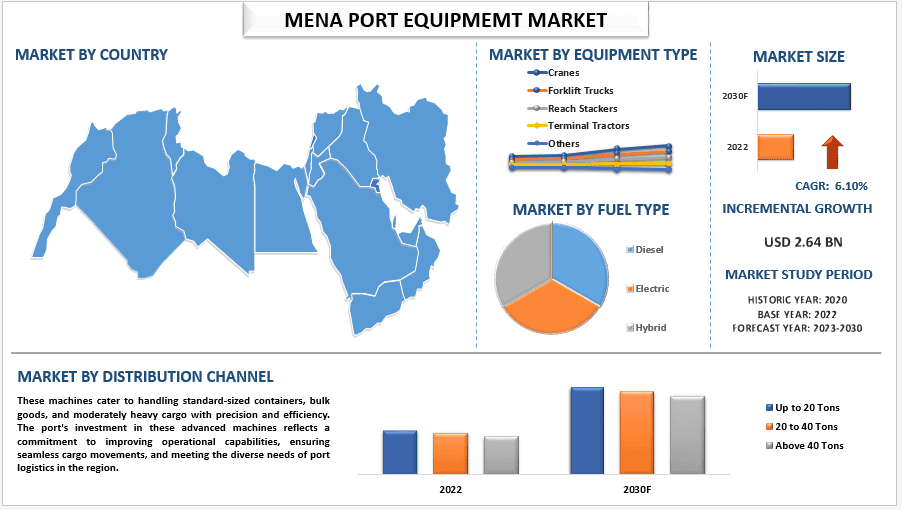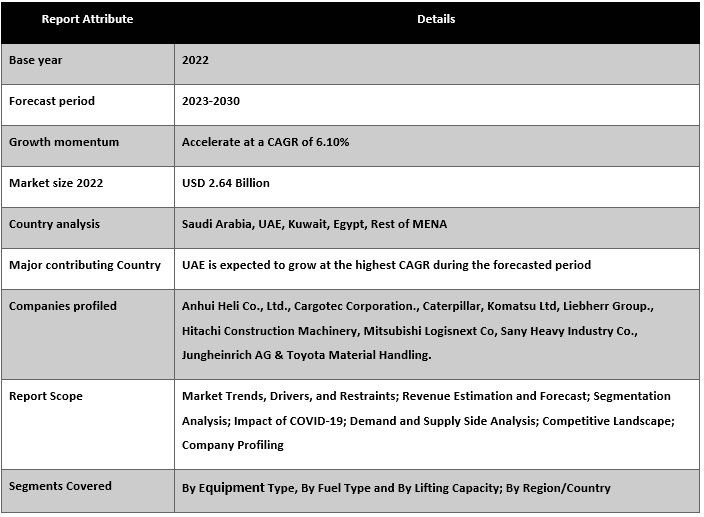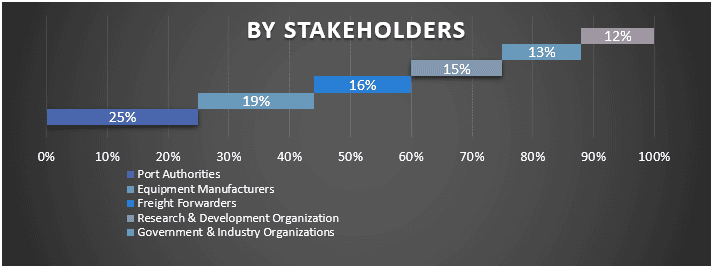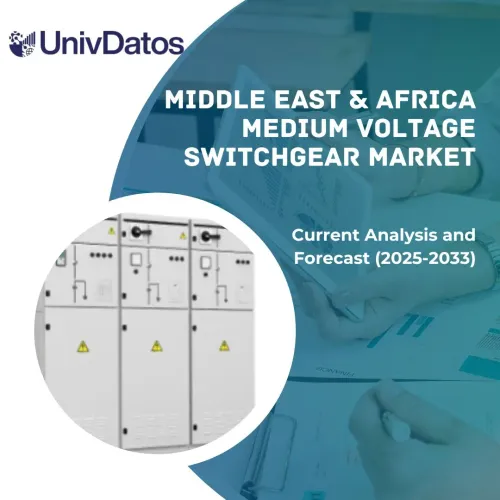- Home
- About Us
- Industry
- Services
- Reading
- Contact Us
MENA Port Equipment Market: Current Analysis and Forecast (2023-2030)
Emphasis on Equipment Type (Cranes, Forklift Trucks, Reach Stackers, Terminal Tractors, Others); Fuel Type (Diesel, Electric, and Hybrid); Lifting Capacity (up to 20 tons, 20 to 40 tons, above 40 tons); and Country.

The MENA Port Equipment Market is expected to reach USD 2.64 Billion in 2030 by growing at a CAGR of 6.10%. The Middle East and North Africa (MENA) region has witnessed a significant surge in the adoption of port equipment in recent years. This trend can be attributed to various factors, including the booming trade activities, increasing containerization of goods, and the continuous development of maritime infrastructure. The utilization of advanced port equipment, such as container cranes, straddle carriers, and automated guided vehicles, has proven instrumental in enhancing the efficiency and productivity of ports across the MENA region. In 2021, the UAE witnessed a significant increase in investments in port infrastructure and the adoption of state-of-the-art equipment. One notable instance is the Jebel Ali Port in Dubai, which introduced automated container terminals that enhance efficiency and productivity.
Some of the major players operating in Anhui Heli Co., Ltd., Cargotec Corporation., Caterpillar, Komatsu Ltd, Liebherr Group., Hitachi Construction Machinery, Mitsubishi Logisnext Co, Sany Heavy Industry Co., Jungheinrich AG & Toyota Material Handling. Several M&As along with partnerships have been undertaken by these players to facilitate customers with hi-tech and innovative products/technologies.
Insights Presented in the Report
“Amongst equipment type, the market is segmented into cranes, forklift trucks, reach stackers, terminal tractors, others. Forklifts Trucks held a significant share of the market in 2022.”
Amongst the equipment type, the market is segmented into cranes, forklift trucks, reach stackers, terminal tractors, and others. Forklifts Trucks held a significant share of the market in 2022. The growing adoption of forklift trucks in ports stems from their pivotal role in optimizing cargo handling processes. These versatile machines offer the agility and lifting capacity necessary to efficiently manage containers and pallets, streamlining operations within port facilities. Forklift trucks contribute significantly to enhancing productivity and reducing manual labor, allowing for quicker loading, and unloading of ships. Their adaptability to various cargo types, from heavy containers to fragile goods, makes them indispensable in the bustling environment of ports.
“Amongst fuel type, the market is bifurcated into diesel, electric, hybrid. Electric segment has high market size with the significant CAGR in 2022.”
Amongst the fuel type, the market is bifurcated into diesel, electric, hybrid. The electric segment has high market size with the significant CAGR in 2022. Electrically powered machinery, including cranes, forklifts, and terminal tractors, has gained traction due to their reduced carbon footprint and lower operational costs. This equipment not only diminishes noise pollution but also curbs emissions, aligning with stringent environmental regulations. The growing availability of advanced battery technologies and charging infrastructure has bolstered confidence in electric port equipment, ensuring uninterrupted operations while contributing to the overarching goal of greener, more efficient port management.
“UAE dominated the market.”
The United Arab Emirates (UAE) has been at the forefront of adopting advanced port equipment in the Middle East and North Africa (MENA) region. In 2021, the UAE witnessed a significant increase in investments in port infrastructure and the adoption of state-of-the-art equipment. One notable instance is the Jebel Ali Port in Dubai, which introduced automated container terminals that enhance efficiency and productivity. These terminals utilize advanced robotics and artificial intelligence technologies to facilitate seamless operations, reducing delays and improving cargo handling processes. The investment in such high-tech port equipment reflects the UAE’s commitment to becoming a global logistics hub and boosting its trade capabilities.
MENA Port Equipment Market Report Coverage

Reasons to buy this report:
- The study includes market sizing and forecasting analysis validated by authenticated key industry experts.
- The report presents a quick review of overall industry performance at one glance.
- The report covers an in-depth analysis of prominent industry peers with a primary focus on key business financials, product portfolios, expansion strategies, and recent developments.
- Detailed examination of drivers, restraints, key trends, and opportunities prevailing in the industry.
- The study comprehensively covers the market across different segments.
- Deep dive regional level analysis of the industry.
Customization Options:
The MENA Port Equipment market can further be customized as per the requirement or any other market segment. Besides this, UMI understands that you may have your own business needs, hence feel free to connect with us to get a report that completely suits your requirements.
Table of Content
Research Methodology for the MENA Port Equipment Market Analysis (2023-2030)
Analyzing the historical market, estimating the current market, and forecasting the future market of the MENA port equipment market were the three major steps undertaken to create and analyze the adoption of MENA port equipment in major countries. Exhaustive secondary research was conducted to collect the historical market numbers and estimate the current market size. Secondly, to validate these insights, numerous findings and assumptions were taken into consideration. Moreover, exhaustive primary interviews were also conducted, with industry experts across the value chain of the MENA port equipment market. Post assumption and validation of market numbers through primary interviews, we employed a top-down/bottom-up approach to forecasting the complete market size. Thereafter, market breakdown and data triangulation methods were adopted to estimate and analyze the market size of segments and sub-segments of the industry pertains to. Detailed methodology is explained below:
Analysis of Historical Market Size
Step 1: In-Depth Study of Secondary Sources:
Detail secondary study was conducted to obtain the historical market size of the MENA port equipment market through company internal sources such as annual reports & financial statements, performance presentations, press releases, etc., and external sources including journals, news & articles, government publications, competitor publications, sector reports, third-party database, and other credible publications.
Step 2: Market Segmentation:
After obtaining the historical market size of the MENA port equipment market, we conducted a detailed secondary analysis to gather historical market insights and share for different segments & sub-segments for major regions. Major segments are included in the report as equipment type, fuel type, and lifting capacity. Further country-level analyses were conducted to evaluate the overall adoption of testing models in that region.
Step 3: Factor Analysis:
After acquiring the historical market size of different segments and sub-segments, we conducted a detailed factor analysis to estimate the current market size of the MENA port equipment market. Further, we conducted factor analysis using dependent and independent variables such as equipment type, fuel type, and lifting capacity of the MENA port equipment market. A thorough analysis was conducted for demand and supply-side scenarios considering top partnerships, mergers and acquisitions, business expansion, and product launches in the MENA port equipment market sector across the globe.
Current Market Size Estimate & Forecast
Current Market Sizing: Based on actionable insights from the above 3 steps, we arrived at the current market size, key players in the MENA port equipment market, and market shares of the segments. All the required percentage shares split, and market breakdowns were determined using the above-mentioned secondary approach and were verified through primary interviews.
Estimation & Forecasting: For market estimation and forecast, weights were assigned to different factors including drivers & trends, restraints, and opportunities available for the stakeholders. After analyzing these factors, relevant forecasting techniques i.e., the top-down/bottom-up approach were applied to arrive at the market forecast for 2030 for different segments and sub-segments across the major markets. The research methodology adopted to estimate the market size encompasses:
- The industry’s market size, in terms of revenue (USD) and the adoption rate of the MENA port equipment market across the major markets domestically
- All percentage shares, splits, and breakdowns of market segments and sub-segments
- Key players in the MENA port equipment market in terms of products offered. Also, the growth strategies adopted by these players to compete in the fast-growing market
Market Size and Share Validation
Primary Research: In-depth interviews were conducted with the Key Opinion Leaders (KOLs) including Top Level Executives (CXO/VPs, Sales Head, Marketing Head, Operational Head, Regional Head, Country Head, etc.) across major regions. Primary research findings were then summarized, and statistical analysis was performed to prove the stated hypothesis. Inputs from primary research were consolidated with secondary findings, hence turning information into actionable insights.
Key Stakeholders of MENA Port Equipment Market in the MENA Region

Market Engineering
The data triangulation technique was employed to complete the overall market estimation and to arrive at precise statistical numbers for each segment and sub-segment of the MENA port equipment market. The data was split into several segments & and sub-segments post studying various parameters and trends in the areas of the equipment type, fuel type, and lifting capacity of the MENA port equipment market.
The main objective of the MENA port equipment Market Study
The current & future market trends of the MENA port equipment market were pinpointed in the study. Investors can gain strategic insights to base their discretion for investments on the qualitative and quantitative analysis performed in the study. Current and future market trends determined the overall attractiveness of the market at a regional and country level, providing a platform for the industrial participant to exploit the untapped market to benefit from a first-mover advantage. Other quantitative goals of the studies include:
- Analyze the current and forecast market size of the MENA port equipment market in terms of value (USD). Also, analyze the current and forecast market size of different segments and sub-segments
- Segments in the study include areas of the equipment type, fuel type, and lifting capacity.
- Define and analysis of the regulatory framework for the MENA port equipment industry
- Analyze the value chain involved with the presence of various intermediaries, along with analyzing customer and competitor behaviors of the industry
- Analyze the current and forecast market size of the MENA port equipment market for the major region
- Major countries of regions studied in the report include Saudi Arabia, UAE, Kuwait, Egypt, and Rest of MENA
- Company profiles of the MENA port equipment market and the growth strategies adopted by the market players to sustain in the fast-growing market
- Deep dive regional level analysis of the industry
Frequently Asked Questions FAQs
Q1: What is the current market size and growth potential of the MENA port equipment market?
Q2: What are the driving factors for the growth of the MENA port equipment Market?
Q3: Which segment has the largest share of the MENA port equipment market by equipment Type?
Q4: Which country will dominate the MENA Port Equipment market?
Q5: Who are the key players operating in the MENA port equipment market?
Related Reports
Customers who bought this item also bought










